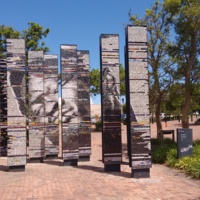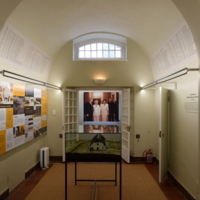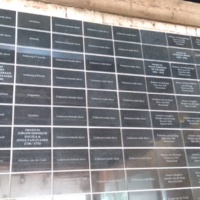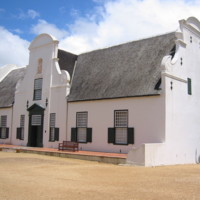
Spier
Spier is a wine estate, situated east of Cape Town close to Stellenbosch. It was founded in 1692 and, as with the majority of South African wine farms of a similar age, its early labour force rested on enslavement. Spier was one of the first wine farms to develop itself as a tourist attraction during the 1960s and 1970s, reflecting a shift in the Winelands economy from just the production of wine. Presently, Spier offers visitors a number of restaurants, wine tasting, conferencing facilities, accommodation, a market, and a variety of estate tours including by Segway. Historical features have been preserved and form part of these tours.
Spier is quite open about its past involvement in slavery. The 1825 slave bell has been restored and is highlighted on the audio tour of the estate. In 2012, an art piece named ‘The Dying Slave’ was designed by the South African artist Marco Cianfanelli and installed at the base of the hotel car park at Spier. This large and imposing structure consists of nine columns which, when the viewer stands at a distance, combine to produce an image which was inspired by Michelangelo’s image of a ‘Dying Slave’.
More obvious local connections with slavery are evident in the ‘Gables' audio tour launched in 2012. This is narrated by a fictional enslaved woman named Sannie de Goede and set in 1836 on the eve of the ending of the apprenticeship period. Using the smartphone app VoiceMap, the narrator guides the visitor around the estate, drawing attention to historical features from the perspective of someone who was forced to work on the estate. Written by playwright Brett Bailey, it should be viewed as part of a genre of historical fiction including works such as Yvette Christianse’s Unconfessed which seek to fill gaps in the colonial archive by reimaging the voices of enslaved women.

Vergelegen
Vergelegen is a wine estate, founded in 1700 and presently owned by Anglo-American subsidy AmFarms. As with the majority of South African wine farms of such a vintage, its early labour force rested on enslavement. Historical interpretation on the estate can be traced to an archaeological dig conducted by a team of academics from the University of Cape Town between 1990 and 1992. At a time of burgeoning scholarly enquiry into Cape slavery, this work excavated the former slave lodge on Vergelgen with the explicit intention of unearthing items which might hint towards the existence of slave culture. A number of personal items including coins and buttons were discovered, whilst the most significant find was of the skeletal remains of an enslaved woman who was affectionately named ‘Flora’ by estate staff.
The results of the archaeological work were displayed in the estate’s foyer together with contextual information. This made Vergelegen probably the first location in South Africa to mount a detailed exhibition relating to Cape slavery. The existence of the archaeological objects can be considered particularly significant, given that few tangible links with Cape slavery exist in museum collections. A second exhibition focussing on Vergelegen’s historical owners was developed several years later in the former manor house, and both exhibitions were subsequently amalgamated prior to being refreshed in 2016.
Presently, the names of people known to have been enslaved on Vergelegen are listed on the wall/ceiling of the first gallery, whilst the origins of enslaved people and their role on the estate are made clear. The objects unearthed during the early 1990s are displayed as tangible links with a past described by text. Additional historical context focuses on wine farming and the early Cape economy, historical estate owners, and notable visitors to Vergelegen.

Solms Delta
Solms Delta is a wine estate, situated east of Cape Town in the heart of the Cape Winelands. It was founded as Zandvleit in 1690, with the name change coming in 2002 after purchase by University of Cape Town-based neurosurgeon Mark Solms who wished to distinguish it from other farms with the same name. As with the majority of South African wine farms of a similar age, its early labour force rested on enslavement. Solms approach to farm ownership has seen him attempt to eschew the well-worn white owner/black worker relationship by launching a socio-economic reform project. Money has been invested in new housing featuring satellite television, whilst an education project both for workers and their children has been established. Social enrichment activities based around music, sports, and performance have been encouraged in an attempt to improve the traditionally poor socio-economic circumstances of the workers, many of whom live on the estate just as their ancestors did. Solms has explained in interviews that this refreshed approach to wine farming arises from a perceived responsibility to acknowledge his own life privileges as a white South African. Crucially, workers have been given shares in a land equity scheme.
Solms Delta hosts two museums. One of these, named Museum van de Caab with deference to Cape slave naming patterns, opened at the same time as the estate opened to the public in 2005, with a music museum opening in 2014. Acknowledgement of the past as a means of understanding how workers have been exploited over time is a crucial part of Solms’ project. Slavery is referenced in both museums, with songs as evidence of slave culture appearing in the music museum. In Museum van de Caab it forms a fundamental part of a general farm history which traces the story of the land to the origins of humankind. A memorial feature occupies a prominent position in one of two galleries, detailing the names of every person revealed by archival research to have been enslaved on the estate. Guided museum and estate tours are available, conducted by estate workers.

Groot Constantia
Founded in 1685, Groot Constantia is South Africa’s oldest wine estate. Like the majority of wine estates of a similar vintage in the Cape Town area, its labour force prior to emancipation in 1834 rested on enslavement. Following a vine disease outbreak in the late nineteenth century, the estate passed into government ownership. It is currently operated by the arms-length Groot Constantia Trust. The manor house was rebuilt in Cape Dutch style following a fire in 1925, and has operated as a preserved site since that time. The manor house passed into the control of the South African Cultural History Museum in 1969 and, as with other sites managed by the same entity, became part of southern state-funded umbrella Iziko Museums in 1998.
Iziko’s inauguration signalled a shift towards previously marginalised histories at all its sites, with Groot Constantia no different. A revised history of Groot Constantia paying greater attention to enslaved people was written by curator Thijs van der Merwe and published in 1997. Buildings which had potentially served either as stables and/or as slave quarters were repurposed as an Orientation Centre in October 2004. As the first heritage space which the visitor reaches upon arrival, displays in this building foreground the Cloete family – owners from 1779 to 1885 – as ‘farm owners and slave owners’. Drawn from archival research, their human transactions are listed, whilst the origins, names, and worked carried out by people enslaved at Groot Constantia are also listed. A panel is devoted to the ‘young servant boy’ Friday, whose ancestral origins are linked to the suppression of the slave trade by the British Royal Navy. The selection of this story can partially be attributed to the availability of suitable museological material, given that a photograph of Friday carrying Bonnie Cloete’s archery set is included.